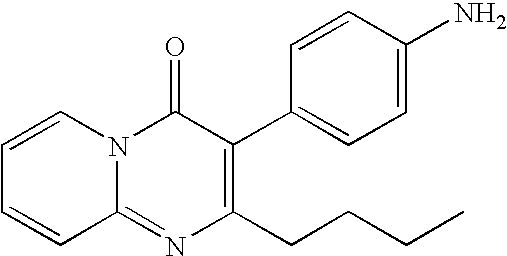Pyridopyrimidinone compounds useful in treating sodium channel-mediated diseases or conditions
a technology of sodium channel-mediated diseases or conditions, which is applied in the field of pyridopyrimidinone compounds, can solve the problems of major pathophysiological conditions, major changes, and unoptimized potency and therapeutic index of these blockers, and achieve the effect of reducing adverse events and increasing the potency of existing or future drug therapies
- Summary
- Abstract
- Description
- Claims
- Application Information
AI Technical Summary
Benefits of technology
Problems solved by technology
Method used
Image
Examples
preparation 1
Preparation of 3-bromo-2-butyl-4H-pyrido[1,2-a]pyrimidin-4-one
A. Preparation of 3-oxo-N-pyridin-2-ylheptanamide
[0550]3-oxoheptoic acid ethyl ester (6.20 g, 36 mmol) and 2-aminopyridine (2.82 g, 30 mmol) was heated at 110° C. for 16 hours. The solid was precipitated and filtered, washed by hexane (10 mL) and dried to give 3-oxo-N-pyridin-2-ylheptanamide as a light yellow solid (2.61 g, 40%): 1H NMR (300 MHz, CDCl3) δ 9.50-9.35 (br, 1H), 8.31-8.10 (m, 2H), 7.73-7.65 (m, 1H), 7.08-6.99 (m, 1H), 3.56 (s, 2H), 2.57 (t, J=7.5 Hz, 2H), 1.65-1.52 (m, 2H), 1.38-1.25 (m, 2H), 0.89 (t, J=7.5 Hz, 3H).
B. Preparation of 2-butyl-4H-pyrido[1,2-a]pyrimidin-4-one
[0551]3-oxo-N-pyridin-2-ylheptanamide (2.60 g, 11.8 mmol) was stirred in concentrated sulfuric acid (15 mL) at ambient temperature for 48 hours. The above mixture was poured into ice, ammonia was added to adjust pH>9. The resulting mixture was extracted with ether (3×50 mL), the combined organic layers was dried over anhydrous sodium sulfate,...
preparation 2
Preparation of 3-bromo-2-methyl-4H-pyrido[1,2-a]pyrimidin-4-one acetate
[0553]A solution of 2-aminopyridine (7.5 g, 79.8 mmol) and ethyl 3-oxobutanoate (11.0 mL, 87.8 mmol) in acetic acid (50.0 mL) was refluxed for 72 hours. The reaction mixture was cooled to ambient temperature for 2 hours where colorless crystals were produced. The crystalline solid was filtered, washed with cold diethyl ether and air dried to give 2-methyl-4H-pyrido[1,2-a]pyrimidin-4-one acetate as a color less solid (6.5 g). To a solution of 2-methyl-4H-pyrido[1,2-a]pyrimidin-4-one acetate in acetic acid (100.0 mL) was added bromine (4.80 g, 29.7 mmol) dropwise over 5 minutes. The resulting solution was stirred at ambient temperature for 30 minutes and additional acetic acid (50.0 mL) was added to free up the solid that precipitated. The solid was filtered and rinsed with diethyl ether (100.0 mL) and air dried to afford 3-bromo-2-methyl-4H-pyrido[1,2-a]pyrimidin-4-one acetate (9.20 g, 100%) as a pale orange solid...
preparation 3
Preparation of 3-bromo-2-(trifluoromethyl)-4H-pyrido[1,2-a]pyrimidin-4-one
[0554]A solution of 2-aminopyridine (11.6 g, 123 mmol), and ethyl 4,4,4-trifluoroacetoacetate (25.0 g, 136 mmol) in acetic acid (100.0 mL) was heated at reflux for 24 hours. The reaction solution was cooled down to ambient temperature followed by the addition of a solution of bromine (23.9 g, 149 mmol) in acetic acid (50.0 mL). The yellow reaction solution was stirred at ambient temperature for 3 hours. The precipitate was filtered to afford 3-bromo-2-(trifluoromethyl)-4H-pyrido[1,2-a]pyrimidin-4-one hydrobromide (12.8 g, 45%) as a yellow solid: 1H NMR (300 MHz, DMSO-d6) δ 9.01-8.98 (m, 1H), 8.12 (ddd, J=8.8, 8.8, 1.5 Hz, 1H), 7.88 (dd, J=8.8, 8.8 Hz, 1H), 7.55 (ddd, J=6.6, 6.9, 1.4 Hz, 1H); 13C NMR (75 MHz, DMSO-d6) δ 155.8, 148.8 (d, 1JCF=276 Hz), 128.6, 126.9, 121.2 (d, 2JCF=64 Hz), 119.5, 98.0; MS (ES+) m / z 193.2 (M+1), 195.1 (M+1).
PUM
| Property | Measurement | Unit |
|---|---|---|
| Pharmaceutically acceptable | aaaaa | aaaaa |
Abstract
Description
Claims
Application Information
 Login to View More
Login to View More - R&D
- Intellectual Property
- Life Sciences
- Materials
- Tech Scout
- Unparalleled Data Quality
- Higher Quality Content
- 60% Fewer Hallucinations
Browse by: Latest US Patents, China's latest patents, Technical Efficacy Thesaurus, Application Domain, Technology Topic, Popular Technical Reports.
© 2025 PatSnap. All rights reserved.Legal|Privacy policy|Modern Slavery Act Transparency Statement|Sitemap|About US| Contact US: help@patsnap.com



